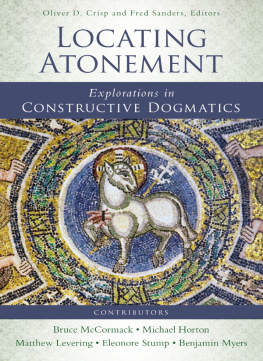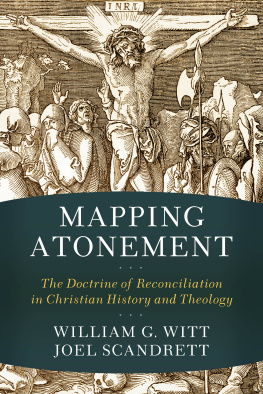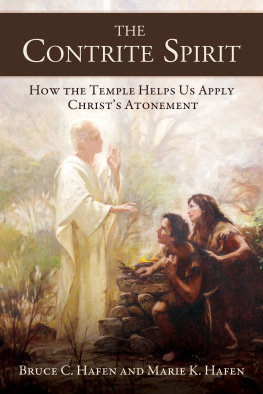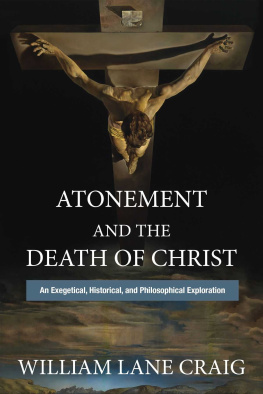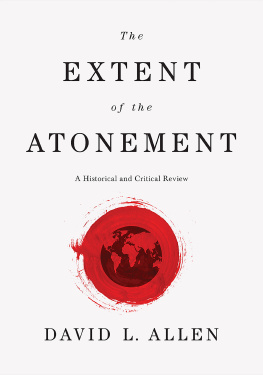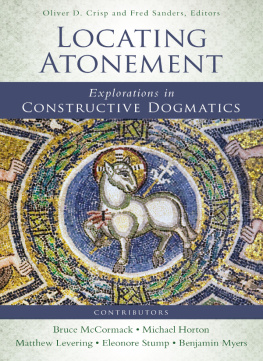T he Fathers, from Origen onwards, are known for their crude metaphors of fish-hooks and bait and their ideas about the devil having legal rights and being cheated by God and humankind being ransomed from the devil by the giving of Christs life. Hand-in-hand with the ransom-to-Satan theory went the recapitulation theory. Briefly, this was the idea that Christ was the Second Adam, the new Head of humanity. He retraced the steps of Adam, successfully resisting sin and evil in all the ways that Adam failed to, culminating in the ultimate act of obedience: death on a cross. These ways of looking at the cross then fell out of vogue as Anselms satisfaction theory, and various responses to it, took center stage from the medieval period onwards. But in the 1930 s, the Swedish theologian Gustav Auln became enthralled with a view of Christ triumphant over demonic principalities and powers. Ever since his time, we call these patristic ideas the Christus Victor way of seeing the cross. More recently still, the ransom-to-Satan theory has been re-appropriated in differing ways in Word of Faith theology, in feminist theology, and by the emerging church movement. All these new developments are quite surprising and rather fascinating.
The main appeal of this Christus Victor view of Christ triumphant at the cross seems to be the motif of resisting evil, and in particular, the fact that Christ did so in a nonviolent way, not answering violence with violence, but rather disabling it with loving obedience. We have here the picture of a hero who has powerfully overcome humankinds worst enemies in the best possible way, and bids us all share in the spoils of his victory.
The ransom-to-Satan theory and the recapitulation theory also carry the kudos that comes from being the first ever reasonably well-developed theories of the atonement. This is massively appealing to those who point to the pre-Constantinian churchthe church before Christendomas the place where we should be learning all the lessons we will need as we try to adapt to post-Christendom. In these new contexts the classic ransom-to-Satan idea is never appropriated wholesale, and neither is the recapitulation idea, but in each case these adaptations seem to be all about a desire to move away from passive, defeatist, or austere ways of being human in favor of something more muscular and less individualistic.
This first chapter will look at the ransom-to-Satan theory specifically. It will examine the context in which the ransom-to-Satan theory first arose, and seek to determine why our contemporary context seems once again to be such a ready receptacle for it.
The Ransom to Satan
Origins : The Context
T he ransom-to-Satan theory arose from a profound awareness of evil. Not only were Christians, until CE, being systematically persecuted but, as McDonald observes:
The condition of the Gentile world made such notions as bondage and release, captivity and ransom, more tragically familiar.... Everywhere economic terror and spiritual fear reigned and intertwined to make human life doubly miserable. Many were enduring bondage and slavery physically, but all were caught up in them spiritually.
So conscious were the early Christians of the pervasiveness of Satanically inspired evil (see the book of Revelation) that they developed strong dualistic tendencies: God on one side, the devil on the other, and no neutral ground in between. This dualism in turn was fed by the now-thriving gnostic theories that were proving so popular as to almost swamp the church.
Gnosticism, a sprawling aggregate of somewhat extravagant beliefs, is divided into certain distinct groups. Grensted claims two typesValentinian and Marcioniteas the true source of the ransom-to-Satan theory. These types of Gnosticism tended to teach something like this: humankind is under the Demiurge. Some humans have the spark of a heavenly nature, and the goal is to free this spiritual inner self by means of enlightenment (gnosis). The inner self must be released from its bondage to matter. How? The revelation of the Logos from the heavenly world. The Logos, an important Greek philosophical idea, was the very mind of the supreme God, spoken out into the world. He alone could grant enlightenment to truly spiritual people and free them from their false attachment to all things material. But, even those who come from the heavenly world, such as the Logos, must not ignore the power of the Demiurge. The Demiurge was the evil demi-god that created this stultifying, unspiritual thing called matter in the first place. Further solution: the Logos must conform outwardly to material conditions. He must not reveal who he really islike a king in disguise. Thus, the Demiurge is deceived by this outward conformity by which a totally cosmic Logos takes on the appearance of physical form in order to defeat the Demiurge and free all those that have the inner spark to be able to live a more spiritual existence.
The missing link between these gnostic ideas and the early Christian doctrine of a Ransom to Satan is a very surprising one. It appears that the very person who was one of the most outspoken early critics of Gnosticism actually borrowed quite extensively from their ideas. His name was Irenaeus (c. CE). Rashdall commented aptly on what was happening here: Irenaeus simply substituted the devil for the Demiurge. And even before Irenaeus came along, writers such as Justin Martyr were equating Jesus with the Greek Logos. Apart from these two slight changes to the leading characters, the drama remains very similar to the gnostic one. Thus, as the theory developed in Origen and Gregory of Nyssa, Christ is seen to take the form of a frail human delivered into the hands of the devil without the devil fully understanding that he had bitten off more than he could chew. He is deceived by outward appearances. The result is the devils defeat and the liberation of Christs people.
Franks points to the Marcionite gnostics as the first to use Cor : (that those who crucified the Lord of glory would not have done so had they known who he was) as a New Testament precedent for the concept that the true God misleads the devil, a passage that would later be quoted very freely in patristic writings in support of the idea that God deceived the devil.
Origins : Emergence
This way of looking at the atonement was soon favored by most of the Fathers, but in varying forms, some more crude than others. Irenaeus, Origen, Gregory of Nyssa, and Augustine each develop the ransom-to-Satan theory in cruder and cruder forms. Two elements emerged progressively, especially from Origen onwards: one, as we have already seen, was that God deceived the devil and the other was that the devils rights over humans were legitimate.
Irenaeus only tentatively introduced the idea that the ransom spoken of in the New Testament was in fact paid to the devil, and did not emphasize the idea that the devil had any legitimate rights over humans. Here is the very first suggestion of the theory. Apostasy here refers to Satan:
And since the apostasy held unjust sway over us, and, though naturally we belonged to God Almighty, had estranged us from Him unnaturally, making us his own disciples, the all-powerful Word of God, who lacks not in His own righteousness, justly turned against that same apostasy, redeeming from it His own not by force, after the manner in which the devil had held sway over us at the first, greedily seizing what was not his own, but by persuasion, even as it befitted God to take what He wished by persuading and not by imposing force, so that there should neither be any infringement of justice, nor should Gods ancient creation perish utterly.



